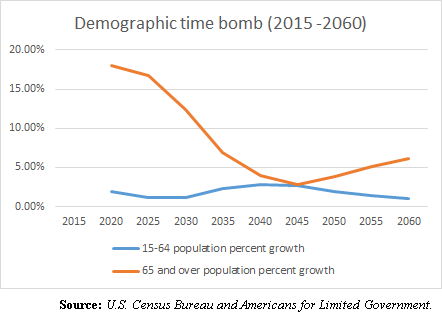From 1985 through 2011, an average 11.7 percent of seniors were enrolled in Medicaid, primarily for long-term nursing home or home and community care, according to data compiled by the Centers for Medicare and Medicaid Services (CMS) and the Bureau of Labor Statistics.
Keep that stat in mind, because if it remains true, as the Baby Boomers progress through old age, by 2030, as many as 8.7 million seniors could be enrolled in the program, up from 4.6 million today, an Americans for Limited Government analysis of the data reveals. By 2035, that figure could rise to about 9.3 million.
And it will drive the costs of the program to the moon, particularly the costs for long-term nursing home and home care targeted at elderly and the physically disabled, which stood at $88.85 billion in 2013. Why?
As the Urban Institute’s Melissa Favreault noted at the Department of Health and Human Services Assistant Secretary for Planning and Evaluation Long-Term Care Financing Colloquium on July 30, “We project that formal long-term services and supports use and costs will roughly track the growth in the aged population.”
That is not good news, particularly considering the older age population wave now underway.
By 2035, the number of seniors will have increased 66 percent to 79.2 million, the U.S. Census Bureau projects. 66 percent.
As jaw-dropping as that is, in the meantime the population of those aged 15-64 will have barely increased 6.65 percent to 232.9 million.
So, how will revenues ever keep up with costs if comparatively fewer Americans will be of working age as a percent of the overall population — for the rest of the century? We’re already running deficits and the answer is, they won’t.
Consider, since 1995, the number of older Americans enrolled in Medicaid has only increased on a net basis by 11.6 percent. And yet, the costs for Medicaid nursing home expenditures are up 75 percent.
If the above ratio holds, the annual tab for long-term care could be as high as half-trillion dollars. And that does not take into account non-seniors who will also be taking advantage of Medicaid.
The explosion of long-term care costs for seniors will be true whether or not Medicaid expansion under the health care law is ever repealed, since qualifying for Medicaid as a senior predates the law’s enactment in 2010.
Seniors constitute most of the costs for those long-term services, about 63 percent, CMS data from 2010 reveals. That includes about 71 percent of nursing home expenditures. As the number of Americans 65 years and older using the program doubles over the next 20 years, that figure should begin rising, along with seniors’ share of overall Medicaid spending.
This puts states in particular in a rather alarming situation. The hundreds of billions that will be spent through Medicaid on long-term care for seniors will be in addition to the hundreds of billions more spent on non-seniors.
Seniors only accounted for 6.7 percent of the 63.7 million Medicaid beneficiaries in 2010, and yet, made up almost a full quarter of benefits paid — $82.6 billion out of its $311 billion budget.
And now, with Medicaid expansion, by 2024 alone, the Congressional Budget Office estimates there could be as many as 93 million Americans enrolled in the program as a whole.
This will get out of control rapidly.
To a certain extent, the health care law attempts to anticipate some of these challenges and included several financing schemes to boost funding for long-term care for the states. Whether their provision was sufficient, and if it was, whether they are sustainable when the money will have to be borrowed remains very much in question.
Much of these schemes attempt to control the costs by replacing senior nursing home care to home care, probably on the presumption that there will not be enough beds and non-institutional care is hopefully cheaper. But even there, there are cost concerns.
A new rule by the Department of Labor enforcing the Fair Labor Standards Act lifted exemptions to the Act that had previously excluded home care workers from minimum wage and overtime pay guarantees. Under the new regime, once the rule takes effect, the costs of home care will necessarily increase — and precisely at the time when demand for those services is about to skyrocket.
Between the demographic time bomb about to go off — that is, the growth of the elderly population far exceeding the growth of the working age population by several orders of magnitude — and then the weak economy, the huge expansion of entitlements under the health care law, and the dramatic increases of the costs of those entitlements, including for labor, what could possibly go wrong?
You do the math. And afterward, if you can figure a way out of this mess, please send a note to Congress. Because they probably have no clue what to do. Repealing the health care law’s Medicaid expansion for non-seniors is just the tip of the iceberg.
Robert Romano is the senior editor of Americans for Limited Government.








